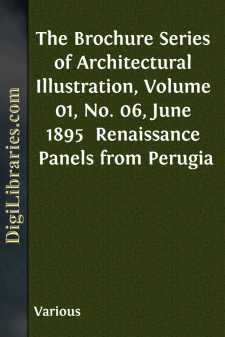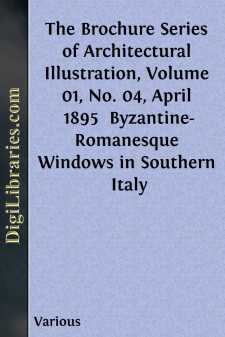Periodicals
- Art
- Children's periodicals 59
- Entertainment 5
- Food/Wine 2
- Games/Humor 455
- General 661
- Health 1
- History 53
- House/Home 1
- Regional 62
- Science/Nature 118
- Transportation 10
Art Books
Sort by:
by:
Various
RENAISSANCE PANELS FROM PERUGIA. The carved walnut panels from the choir stalls of the Church of San Pietro de' Casinense in Perugia, designed by Stefano da Bergamo in 1535, which are given as illustrations in this number, are excellent examples of the ornament of the later period of the Italian Renaissance. This form of ornament was first used in flat painted panels upon pilasters, such as the...
more...
by:
Various
I. SOUTHWEST ANGLE OF THE DUCAL PALACE, VENICE. Although the Ducal Palace is much larger than the other palaces of Venice, and intended for general civic uses as well as a residence for the Duke or Doge, it follows closely the type already described. It has undergone so many changes since its first foundation in about the year 800 (813 according to Ruskin), having been destroyed five times, and as...
more...
by:
Various
r Wilson Eyre, Jr., in an article in The Architectural Review for January, which has been alluded to in our issue for October, and from which we have borrowed the three charming illustrations reproduced from his drawings, speaks as follows of English domestic architecture: “There is much to be seen from the railroad in the way of long rambling farmhouses and country houses of the modest kind, and...
more...
by:
Various
BYZANTINE-ROMANESQUE WINDOWS IN SOUTHERN ITALY. The collection of photographs from which the plates in this and the February number were selected was only recently made under the direction of Signor Boni, an official of the Italian government, charged with the care and restoration of historic monuments. The province of Apulia has been so little invaded by the march of modern improvement, and its...
more...
by:
Various
FRAGMENTS OF GREEK DETAIL. The Art of Greece during the fifth century, B.C., was developed in an amazingly short time from a condition of almost archaic rudeness to that of the greatest perfection which the world has ever seen. At the close of the Persian wars the Athenians, under Pericles, began rebuilding their city and perfecting themselves in all the arts of civilization, and their progress in the...
more...
by:
Various
Pulpits of Southern Italy. The pulpits and ambos chosen for the illustrations in this issue of The Brochures are mainly interesting for their wonderful mosaic decorations which are among the finest of their kind which have ever been executed. The work of the family of Cosmati, by whose name the Roman mosaic or inlay of this description is known, such as that in plate LXXI, is similar in design and...
more...
by:
Various
Abattoirs, 128Aberbrothwick. The Abbey of, 13Aboriginal Races of America. The, 151Accidents:—Fall of a Hotel in Sydney, N.S.W., 184“ “ “ Scaffold, 104“ “ St. Louis Academy of Music, 66“ “ the Roof of the Flora Hall, Hamburg, 196Agreement between Architect and Client, 30Albany Capitol. Defective Gutters on the, 97Aluminium from Bauxite, 194Alva. Statue of the Duke of, 74America. The...
more...
by:
Various
CIVIL AND DOMESTIC ARCHITECTURE.—I. The term Civil and Domestic Architecture includes all public and private edifices, that is to say: honorary monuments, such as triumphal arches and tombs; buildings for the instruction of the public, such as museums, libraries and schools; houses for public amusements, as theatres, amphitheatres and circuses; structures for public service, as city-halls,...
more...
by:
Various
MILLERISM. Toward the close of the last century there was born in New England one William Miller, whose life, until he was past fifty, was the life of the average American of his time. He drank, we suppose, his share of New England rum, when a young man; married a comely Yankee girl, and reared a family of chubby-cheeked children; went about his business, whatever it was, on week days, and when Sunday...
more...
by:
Various
LITERARY COTERIES IN PARIS IN THE LAST CENTURY. The revolutions of society are almost as sure if not as regular as those of the planets. The inventions of a generation weary after a while, but they are very likely to be revived if they have once ministered successfully to pleasure or ambition. The famous coteries in which learning was inter-blended with fashion in the golden age of French intelligence,...
more...











